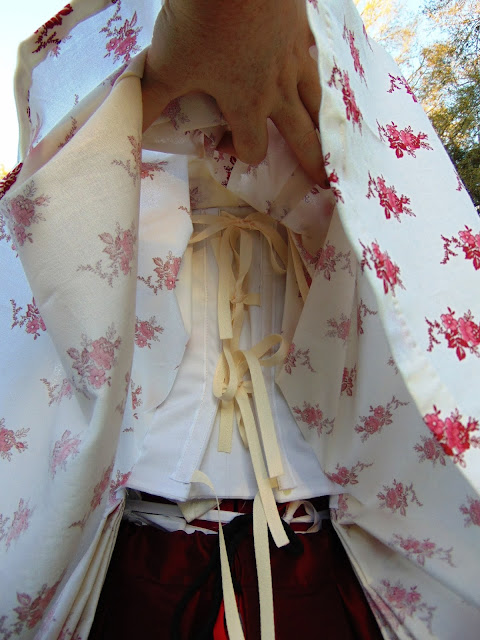Pattern: Self Drafted.
Fabrics: 100% cotton print, 100% silk taffeta.
Measurements:
Chest: 35-37"
Waist: 28-32"
Hip: Free
Shoulders: 17.5" roughly.
Bicep: 13.5" max
Garment Center Back Length: 24.5"
Sadly I didn't take very many construction photos for this one, but there isn't really much unique going on. It's mostly assembled the same way all sack-back style gowns are assembled. The biggest difference is that the fronts are also fully lined, while most sack-back gowns have the fronts "laid over" an unattached lining. Still, this method was used quite a lot with the more casual jackets, and especially those that didn't have folded robings.
(below) here you can see the hand stitching from where the top back piece was applied and folded over. Also the stitching that is attaching the ruching trim.
Even though 18th century garments were often left quite unfinished inside--some are a downright mess!--I'm just not a fan of raw seams. I whip-stitched the sleeves linings into place so they would cover the armhole seam allowance.
The great thing about sack-back gowns and their shorter pet-en-l'air brethren is that they came in so much variety--with ample proof in museum pieces--that we can do so much and still be historically accurate. Folded robings, separate piece robings, no robings at all...waist seams, no waist seams, full sleeves, tight sleeves, long sleeves. Heck, even the quintessential "Watteau" pleating on the back is not a necessity. There are museum pieces showing the backs with just a bunch of box pleats, knife pleats. Even one gathered!
Because of all this, I have a lot of ideas for future versions. I think the next rendition of this I make will have separate piece robings and have the sides longer to be level with the back.





























I love this! Great work. (I've long admired your work you put up for sale.) May I ask where you got the fabric as it's so delightful and feminine?
ReplyDeleteThank you so much! I have to say I also adore your website. I've been going there for years on construction and design tips =)
DeleteI got this fabric off the clearance shelf at Hobby Lobby a few months back. Just enough on the bolt to, so a lucky find lol